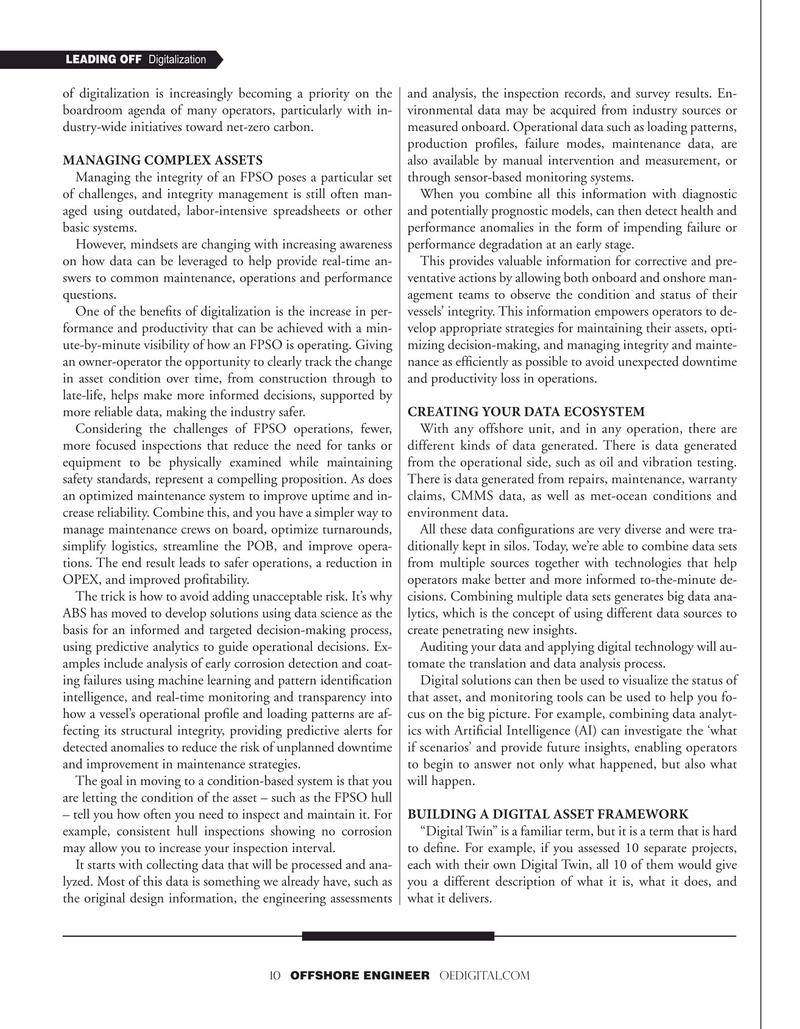
Page 10: of Offshore Engineer Magazine (Sep/Oct 2020)
Read this page in Pdf, Flash or Html5 edition of Sep/Oct 2020 Offshore Engineer Magazine
LEADING OFF Digitalization of digitalization is increasingly becoming a priority on the and analysis, the inspection records, and survey results. En- boardroom agenda of many operators, particularly with in- vironmental data may be acquired from industry sources or dustry-wide initiatives toward net-zero carbon. measured onboard. Operational data such as loading patterns, production profles, failure modes, maintenance data, are
MANAGING COMPLEX ASSETS also available by manual intervention and measurement, or
Managing the integrity of an FPSO poses a particular set through sensor-based monitoring systems. of challenges, and integrity management is still often man- When you combine all this information with diagnostic aged using outdated, labor-intensive spreadsheets or other and potentially prognostic models, can then detect health and basic systems. performance anomalies in the form of impending failure or
However, mindsets are changing with increasing awareness performance degradation at an early stage. on how data can be leveraged to help provide real-time an- This provides valuable information for corrective and pre- swers to common maintenance, operations and performance ventative actions by allowing both onboard and onshore man- questions. agement teams to observe the condition and status of their
One of the benefts of digitalization is the increase in per- vessels’ integrity. This information empowers operators to de- formance and productivity that can be achieved with a min- velop appropriate strategies for maintaining their assets, opti- ute-by-minute visibility of how an FPSO is operating. Giving mizing decision-making, and managing integrity and mainte- an owner-operator the opportunity to clearly track the change nance as effciently as possible to avoid unexpected downtime in asset condition over time, from construction through to and productivity loss in operations. late-life, helps make more informed decisions, supported by more reliable data, making the industry safer. CREATING YOUR DATA ECOSYSTEM
Considering the challenges of FPSO operations, fewer, With any offshore unit, and in any operation, there are more focused inspections that reduce the need for tanks or different kinds of data generated. There is data generated equipment to be physically examined while maintaining from the operational side, such as oil and vibration testing. safety standards, represent a compelling proposition. As does There is data generated from repairs, maintenance, warranty an optimized maintenance system to improve uptime and in- claims, CMMS data, as well as met-ocean conditions and crease reliability. Combine this, and you have a simpler way to environment data. manage maintenance crews on board, optimize turnarounds, All these data confgurations are very diverse and were tra- simplify logistics, streamline the POB, and improve opera- ditionally kept in silos. Today, we’re able to combine data sets tions. The end result leads to safer operations, a reduction in from multiple sources together with technologies that help
OPEX, and improved proftability. operators make better and more informed to-the-minute de-
The trick is how to avoid adding unacceptable risk. It’s why cisions. Combining multiple data sets generates big data ana-
ABS has moved to develop solutions using data science as the lytics, which is the concept of using different data sources to basis for an informed and targeted decision-making process, create penetrating new insights. using predictive analytics to guide operational decisions. Ex- Auditing your data and applying digital technology will au- amples include analysis of early corrosion detection and coat- tomate the translation and data analysis process. ing failures using machine learning and pattern identifcation Digital solutions can then be used to visualize the status of intelligence, and real-time monitoring and transparency into that asset, and monitoring tools can be used to help you fo- how a vessel’s operational profle and loading patterns are af- cus on the big picture. For example, combining data analyt- fecting its structural integrity, providing predictive alerts for ics with Artifcial Intelligence (AI) can investigate the ‘what detected anomalies to reduce the risk of unplanned downtime if scenarios’ and provide future insights, enabling operators and improvement in maintenance strategies. to begin to answer not only what happened, but also what
The goal in moving to a condition-based system is that you will happen. are letting the condition of the asset – such as the FPSO hull – tell you how often you need to inspect and maintain it. For BUILDING A DIGITAL ASSET FRAMEWORK example, consistent hull inspections showing no corrosion “Digital Twin” is a familiar term, but it is a term that is hard may allow you to increase your inspection interval. to defne. For example, if you assessed 10 separate projects,
It starts with collecting data that will be processed and ana- each with their own Digital Twin, all 10 of them would give lyzed. Most of this data is something we already have, such as you a different description of what it is, what it does, and the original design information, the engineering assessments what it delivers. 10 OFFSHORE ENGINEER OEDIGITAL.COM

 9
9

 11
11